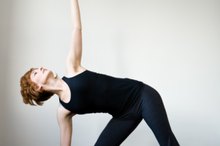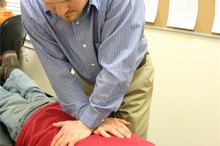How to Heal a Pinched Nerve with Yoga
Pinched nerves are literally a pain in the butt -- or the neck, as well as other junctions along the spine. In addition to pain, likely symptoms include weakness, tingling, numbness or shooting pains in a leg or arm.
Can yoga help? The answer is a resounding "yes." In fact, in February of 2017 the American College of Physicians (ACP) included yoga in its new guidelines as an effective non-invasive therapy to resolve acute lower back pain from pinched nerves and other causes. Although other kinds of pinched nerve pain weren't specifically mentioned, the guidelines are an affirmation of what yoga practitioners have known for ages: Yoga may accomplish what narcotics and neurosurgery can't.
Read More: Yoga to Strengthen the Lower Back
What's a Pinched Nerve, Anyway?
Pinched nerves -- known clinically as radiculopathies -- occur when nerve roots that branch off from the spinal cord are impinged upon by a bone spur, tight muscles or a piece of one of the soft discs that cushion the spine both at the neck and the lower back. When this happens, the nerve becomes irritated and inflamed. Pinched nerves are most likely to occur in the lower back but can also affect the neck or other areas of the spinal cord.
First, Do No Harm
Hiatal Hernia & Yoga Poses
Learn More
While the ACP guidelines acknowledge yoga as a viable treatment, they don't offer much in the way of specifics. When it comes to healing your pinched nerve with yoga, it's wise to follow the Hippocratic Oath: "First do no harm." Common sense and your body's response to certain poses will tell you a lot about whether you're on the right track, and it's important to tell your yoga instructor about your pinched nerve.
Poses for Pinched Nerves
Keep in mind that being over-ambitious in yoga can do more harm than good. Many of the exercises prescribed by physical therapists are derived from yoga, and it's worth consulting with your doctor and/or your physical therapist what you should and shouldn't do. They will have knowledge of anatomy that a yoga instructor may not possess. As always, proper form is essential.
Cobra
Definition of Yoga for Children
Learn More
Cobra decompresses the lumbar and thoracic vertebrae and relieves spinal pressure by extending the abdomen and front of the chest. Cobra is performed by lying face-down; keep your hands under your shoulders and elbows to your sides, push up through the floor from your waist.
Extended Side Angle Pose
Extended Side Angle Pose makes room for the nerves branching off from the spinal cord by lengthening the spine. It involves assuming a modified lunge position from which you rotate your torso upward with arm extended.
Fish Pose
Thoracic Outlet Syndrome is occurs when nerves or blood vessels involved in the thoracic outlet -- the oval passage between the armpit and base of the neck -- are compressed by tight muscles, bone misalignment or scar tissue. Fish pose, an upper back stretch performed lying on your back with your upper torso arched upward, can help break down scar tissue and soften knotted muscle to make more room for the nerves and vessels. It elongates the scalenes, which are the muscles that connect the neck to the top ribs.
Other Poses
For sciatica caused by a bulging disc, the ever-faithful Downward Dog can open vertebrae to help the disc fall back into place. Another cause of sciatica can be piriformis syndrome, which is spasm of the muscle that stretches from the outer sacrum to the top of the thigh bone at the hip joint, passing (and sometimes clamping) over the sciatic nerve on its way down. For this, Fish pose but without the rotating torso is good, as is Revolved Triangle pose.
Read More: Yoga to Banish Neck and Shoulder Pain
- Cobra decompresses the lumbar and thoracic vertebrae and relieves spinal pressure by extending the abdomen and front of the chest.
- Fish pose, an upper back stretch performed lying on your back with your upper torso arched upward, can help break down scar tissue and soften knotted muscle to make more room for the nerves and vessels.
Related Articles
References
- Hochman MG, Zilberfarb JL. Nerves in a pinch: imaging of nerve compression syndromes. Radiol Clin North Am. 2004;42(1):221-45. doi:10.1016/S0033-8389(03)00162-3
- NIH National Institute of Neurological Disorders and Stroke. Pinched nerve information page. Updated March 27, 2019.
- AdventHealth Medical Group. Cauda equina syndrome.
- AAOS OrthoInfo. Cervical radiculopathy (pinched nerve). Updated June 2015.
- Dimitrova A, Murchison C, Oken B. Acupuncture for the treatment of peripheral neuropathy: A systematic review and meta-analysis. J Altern Complement Med. 2017;23(3):164-179. doi:10.1089/acm.2016.0155
- Conger A, Cushman DM, Speckman RA, Burnham T, Teramoto M, McCormick ZL. The Effectiveness of Fluoroscopically Guided Cervical Transforaminal Epidural Steroid Injection for the Treatment of Radicular Pain; a Systematic Review and Meta-analysis. Pain Med. 2019 Jun 10. pii: pnz127. doi:10.1093/pm/pnz127 [Epub ahead of print]
- Keating L, Treanor C, Sugrue J, Meldrum D, Bolger C, Doody C. A randomised controlled trial of multimodal physiotherapy versus advice for recent onset, painful cervical radiculopathy - the PACeR trial protocol. BMC Musculoskelet Disord. 2019 Jun 1;20(1):265. doi:10.1186/s12891-019-2639-4
- Holtzman S, Beggs T. Yoga for chronic low back pain: A meta-analysis of randomized controlled trials. Pain Res Manag. Sept-Oct. 2013.
- Sherman KJ, Cherkin DC, Erro J, Miglioretti DL, Deyo RA. Comparison of Yoga, Exercise, and Education for the Treatment of Chronic Low Back Pain. Annals of Internal Medicine Vol 143 Issue 12 pp1-18. Dec 20 2005.
- Sherman KJ, Cherkin DC, Wellman RD, Cook AJ, Hawkes RJ, Delaney K, Deyo RA. A Randomized Trial Comparing Yoga, Stretching, and a Self-care Book for Chronic Low Back Pain. Arch Intern Med. 2011 Oct 24. [Epub ahead of print]
- Tilbrook HE, Cox H, Hewitt CE, Kang'ombe AR, Chuang LH, Jayakody S, Aplin JD, Semlyen A, Trewhela A, Watt I, Torgerson DJ . Yoga for chronic low back pain: a randomized trial. Ann Intern Med. 2011 Nov 1;155(9):569-78.
Writer Bio
Martin Booe writes about health, wellness and the blues. His byline has appeared in the Washington Post, the Los Angeles Times and Bon Appetit. He lives in Los Angeles.









